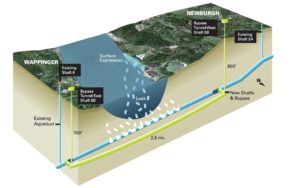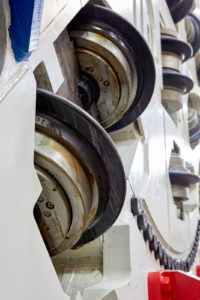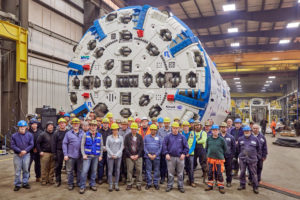![65 Years of Innovation and Experience [default]](https://www.robbinstbm.com/wp-content/uploads/2017/04/Side-Bar-Blue-Blocks_70-Years.jpg)
A Solution for Every Condition: Search our Project Database
Project Map
FEATURED PRODUCT: CROSSOVER MACHINES
Our History
A Legacy of Innovation
Information 24/7
News & Media
Insights in the Industry:
Read the Robbins Blog
 At 137 km (85 mi) long, the Delaware Aqueduct is cited in the Guinness Book of World Records as the world’s longest continuous tunnel. On any given day, it supplies 50-60% of New York City’s drinking water—a metropolis of 8.5 million people—in addition to a further 1 million that live north of the city. It is the largest such water supply tunnel in the United States. In the 1990’s, the New York City Department of Environmental Protection (NYCDEP) discovered that a section of the aqueduct below the Hudson River was leaking 75 million liters of water per day.
At 137 km (85 mi) long, the Delaware Aqueduct is cited in the Guinness Book of World Records as the world’s longest continuous tunnel. On any given day, it supplies 50-60% of New York City’s drinking water—a metropolis of 8.5 million people—in addition to a further 1 million that live north of the city. It is the largest such water supply tunnel in the United States. In the 1990’s, the New York City Department of Environmental Protection (NYCDEP) discovered that a section of the aqueduct below the Hudson River was leaking 75 million liters of water per day.
The NYCDEP took the decision to repair the tunnel in the largest such project to take place in the 175-year history of New York’s water supply system. A key component of the plan is a bypass tunnel that will connect up with structurally sound portions of the aqueduct and run deep below the Hudson for 3.8 km (2.5 mi). Notably, the tunnel will be bored while the aqueduct is still in service—only after excavation of the bypass will the flow be switched off to allow for the new tunnel to be connected to the existing tunnel. That shutdown is expected to last for five to eight months.
At 183 m (600 ft) below the riverbed of the Hudson, the bypass tunnel in faulted, crumbly limestone will be subject to water inflows at high pressures of up to 20 bar. A specialized 6.8 m (22.3 ft) diameter Single Shield TBM, manufactured by Robbins for JV contractor Kiewit-Shea Constructors (KSC), will bore the tunnel using components aimed at enabling efficient excavation in the difficult geological conditions.
 The machine was designed with Difficult Ground Solutions (DGS) features for the unique conditions.
The machine was designed with Difficult Ground Solutions (DGS) features for the unique conditions.
Water Inflow Control Features
Due to the 20 bar static water pressure expected on the project, a new main bearing sealing system was engineered for the project and is comprised of multiple rows of traditional lip type seals and emergency inflatable seals. In the event of a sudden inrush of high-pressure water, the TBM was designed to be quickly sealed. Knife gates over the muck chute are closed, followed by retraction of the conveyor frame and the belting from the cutting chamber. The bulkhead sealing plate is retracted and finally the stabilizer doors are closed.
Drilling & Grouting Systems
he machine is equipped with two drills in the shields for drilling through the head in 16 different positions and a third drill on the erector to drill through the shields in an additional 14 positions. Drilling and pre-excavation grouting will be a routine job to control and minimize water inflows. In addition, water-powered, high pressure down-the-hole-hammers will allow for drilling 60 to 100 m ahead of the machine at pressures up to 20 bar if necessary.
Pressure-Compensating Disc Cutters
The NYCDEP required that the TBM be capable of withstanding 30 bar of hydrostatic pressure. As such, the use of pressure compensated disc cutters became a necessity. Their unique design incorporates a pressure equalization system to keep water out and protect their bearings when the pressure is high.
 Two massive shafts were constructed—launch shaft 5B in Newburgh, New York, and a retrieval shaft in Wappinger on the other side of the Hudson. The shafts were constructed by drill and blast with concrete lining installed every 30 m (100 ft). Their construction was completed in March 2016, resulting in a 270 m (885 ft) deep, 9 m (30 ft) diameter shaft at Newburgh and a 197 m (646 ft) deep shaft at Wappinger.
Two massive shafts were constructed—launch shaft 5B in Newburgh, New York, and a retrieval shaft in Wappinger on the other side of the Hudson. The shafts were constructed by drill and blast with concrete lining installed every 30 m (100 ft). Their construction was completed in March 2016, resulting in a 270 m (885 ft) deep, 9 m (30 ft) diameter shaft at Newburgh and a 197 m (646 ft) deep shaft at Wappinger.
The TBM will be launched from a bell-out chamber with a 12 m high ceiling currently under construction. The Newburgh shaft features a complex logistical setup including an elaborate hoisting system designed to service the shaft. The hoisting system will provide a lifting capacity of up to 90 metric tons to be used during TBM assembly.
Robbins worked closely with KSC to ensure that TBM components were designed and sized so all parts were less than 90 metric tons and could be lifted with the contractor’s hoist system to fit down the narrow, deep shaft window. A factory acceptance test was held in February 2017 After being shipped to the site, the TBM was assembled on a moving cradle at the bottom of the shaft, and then moved to the tunnel face.
In August 2019, The NYCDEP completed excavation of the Delaware Aqueduct Bypass Tunnel, a significant milestone in the USD $1 billion effort to repair leaks in the longest tunnel in the world. The TBM broke through a wall of shale bedrock nearly 700 feet (210 m) below the surface. Excavation of the tunnel was completed on budget and ahead of schedule.

 Close
Close